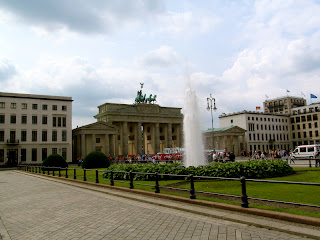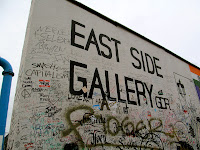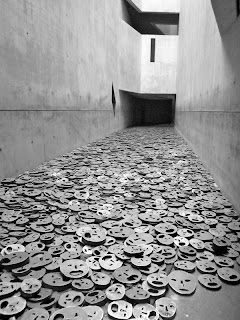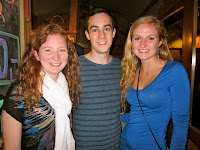Berlin
I am so glad that I was able to squeeze this trip to Berlin into my final days here in Europe. This city was an important place to go see and my dad kept saying that I should really try to get myself over to it. I didn't realize how East the city is located. I am still conquering the geography of Europe, it takes time. I was able to get 2.5 days in Berlin. I traveled with Alex, another person from my program. She lives in Atlanta and goes to school at Georgetown. We were both were very impressed with the city. I have heard great things from various people who were there before.
Personal advertisements:
Fly Air Berlin, you won't regret it.
Stay at Raise a Smile Hostel. The hostel opened in December 2009 by members of the charity Raise a Smile in order to raise funds to support schools and orphanage projects in Zambia. Raise a Smile is a non-profit English-German charity organization. They support children in various projects in Zambia (a developing country in Southern Africa). Their main focus is on education, as they believe that education is the most powerful tool that can be used to escape poverty. The hostel has a Zambian theme so you can experience a bit of Africa in the heart of East Berlin. I stayed in the Zebra eight-bed room and I even made a few donations for a Zebra keychain to remember my stay in Africa, no Berlin. In all seriousness though, this hostel is working for a great cause, and it was my privilege to stay there and meet these incredible people who are doing incredible work. Without even realizing it, I made a contact in my networking web for some future volunteer work in Africa. Raise a Smile created a small homely backpacker style hostel for travellers and is designed to try and encourage social interactions between guests. We went out to dinner downtown with four new friends we met from the Hostel, three girls from London and one guy from my neck of the woods (states), Burlington. Boy, did I gush about my love for everything Burlington. Living in that city is on the top of my forever extending bucket list..It was neat reminiscing about New England, and trying to convince the English girls to visit Boston rather than NYC. I always favor Boston no matter where I go. We also met a guy from LA, he was pretty impressive because he has been traveling throughout Europe for 8 (count them) months. Jeez, I thought I was homesick...
Back to Berlin we go!
Places We Visited:
The Brandenburg Gate is an iconic landmark of Berlin and Germany. It is located on the Paris Platz and has many important buildings surrounding it including the French Embassy, the U.S. Embassy and the ........Hotel (infamous for being the site where Michael Jackson hung the baby out from his balcony, who knew that took place in Berlin? not I). On the other side of the gate is where the Berlin Fan Zone is located for the Euro2012. The is a huge tv set up on a stage for fans to view the games. Alex and I went to watch the Germany game that night with thousands of German fans.

Memorial to the Murdered Jews of Europe. The Memorial to the Murdered Jews of Europe, also known as the Holocaust Memorial is a memorial to the Jewish victims of the Holocaust, designed by architect Peter Eisenman. It consists of a 4.7 acres site covered with 2,711 concrete slabs, arranged in a grid pattern on a sloping field. According to Eisenman's project text, the slabs are designed to produce an uneasy, confusing atmosphere, and the whole sculpture aims to represent a supposedly ordered system that has lost touch with human reason.
Here is my dash attempt to describe the many emotions one feels walking through this memorial:
loneliness. can't walk side by side, you have to walk alone.
dehumanization, no names or labeling of memorial.
slabs, funeral.
grey, dreary, dark.
the slopping center makes it really dark while in the middle of the chaos. but you are always able to see you're way out, see the light at the end of the dark tunnel...
no use of any symbolism.
Visitors can move through the tilting featureless stones - each one a unique shape and size - from any direction. There are no plaques, inscription or symbols along the way.

An attached underground "Place of Information" holds the names of all known Jewish Holocaust victims, obtained from Yad Vashem in Israel. a visitors' center offers information and context on the Nazi campaign against the Jews. The information center has 8 exhibits. The one that I found most powerful was the Room of Dimensions. This room centers on diary entries, letters and last notes that were written during the Holocaust. Another room, the Room of Families show various Jewish lifestyles, using the example of 15 families. Photos and documents reflect the variety of European Jewish culture before the Holocaust and illustrate the destruction, displacement and murder of these families.


Hitler's Bunker
Hitler's Bunker is located underneath this car park located a block from the Memorial to the Murdered Jews of Europe. This site is unmarked and the bunker is sealed off. It was decided that there should be no memorializing of this site because people worried that it might become a site of Neo-Nazi pilgrimages.
Hitler took up residence in the
Fuhrerbunker on 16 January 1945 and it became the epicenter of the Nazi regime until the last week of World War II. HItler married Eva Braun here during the last week of Apirl 1945, shortly before they committed suicide.
Berlin Wall.
Alas! I lay eyes on the original Berlin Wall in the city where it was located. Throughout my travels I have seem sections of the wall, like in Gdansk and Budapest. But finally I am in the city where it all happened.
The Berlin Wall was a barrier constructed by the German Democratic Republic (GDR, East Germany) starting on 13 August 1961, that completely cut off West Berlin from surrounding East Germany and from East Berlin. The barrier included guard towers placed along the large concrete walls, which circumscribed a wide area (known as the "death strip") that contained all sorts of weapons which were aimed to kill any escapees.


Since its initial construction the wall was remodeled and revamped throughout the years that it held power. The wall at one point had barbed wire on the top of it, but that was later taken down because it was well known that people trying to escape and climb over the wall used the barbed wire to grasp and pull themselves over. At one point, German olympians were brought in to test the durability of the wall. This lead to the addition of the pipes that you see on top of the wall now. These pipes (some type of sewer pipes) are just round enough for it to be impossible for anyone to get their arms around. Tricky huh.
Checkpoint Charlie
Checkpoint Charlie (C) was the name given by the Allies to the best-known Berlin Wall crossing point between East Berlin and West Berlin during the Cold War. Checkpoint Charlie was designated as the single crossing point (by foot or by car) for foreigners and members of the Allied forces.

The guard house viewed from what was the American sector. Beyond it is a mast with an image of a Soviet soldier looking towards the American side. And at this view, is an American soldier looking into the Soviet side, always watching.

 |
| Replica of the famous sign at the former East-West Berlin border. |
The Burning of Banned Books

The Nazi book burnings were a campaign conducted by the authorities of Nazi Germany to ceremonially burn all books in Germany which did not correspond with Nazi ideology.
Among the thousands of books burned on Berlin's Opernplatz in 1933, following the Nazi raid, were works by Heinrich Heine, the beloved nineteenth-century German-Jewish poet. To commemorate the terrible event, one of the most famous lines of Heine's 1821 play
Almansor was engraved in the ground at the site: "That was but a prelude; where they burn books, they will ultimately burn people also."
East Side Gallery
The East Side Gallery is an international memorial of freedom. It is a 1.3 km long section of the Berlin Wall. The Gallery consists of 105 paintings by artists from all of the world, painted in 1990 on the east side of the Berlin Wall. The paintings document the time of change and express the euphoria and great hopes for a better and free future for all people of the world. It is possibly the longest-lasting open air gallery in the world.
 |
| A popular slogan graffitied on one of the sections of the East Side Gallery, reading: "No more wars. No more walls. A united world." |
Topography of Terror:
The Topography of Terror is an outdoor museum. It is located on the site of buildings which during the Nazi regime from 1933 to 1945 were the headquarters of the Gestapo and the SS. The buildings that housed the Gestapo and SS headquarters were largely destroyed by Allied bombing during early 1945 and the ruins demolished after the war. The boundary between the American and Soviet zones of occupation in Berlin ran along this street, so the street soon became a fortified boundary, and the Berlin Wall ran along the south side of the street from 1961 to 1989. The wall here was never destroyed. Indeed the section adjacent to the Topography of Terror site is the longest extant segment of the outer wall (the longer East Side Gallery section is actually part of the inner wall, not visible from West Berlin).

New Synagogue
The Neue Synagogue was built 1859-1866 as the main synagogue of the Berlin Jewish community. it was badly damaged prior to and during World War II and subsequently much was demolished; the present building on the site is a reconstruction.

During the November Pogrom (9-10 November 1938),
Kristallnacht, the Neue Synangogue was set ablaze, Torah scrolls desecrated, furniture smashed and other combustible furnishings piled up and set on fire.

We happen to stumble upon this breathtaking building by chance. We caught a glimpse of a sign for it and just ventured our way to it, I am so glad that we saw it though, it is incredible up close.
Reichstag
The Reichstag building is a historical edifice in Berlin, constructed to house the
Reichstag, parliament of the German Empire. It was opened in 1894 and housed the
Reichstag until 1933, when it was severely damaged in a fire. After World War II, the building fell into disuse. In 1990, it underwent a reconstruction and after its completion in 1999, it once again became the meeting place of the German parliament: the modern Bundestag. The Reichstag is now the second most visited attraction in Germany, not least because of the huge glass dome that was erected on the roof as a gesture to the original 1894 cupola, giving an impressive view over the city, especially at night (we were there in the morning, and i must saw it was still an impressive view, nonetheless).
More on the huge glass dome:

The large glass dome at very top of the Reichstag has a 360 degree view of the surrounding Berlin cityscape. The main hall of the parliament below can also be seen from inside the dome, and natural light from above radiates down to the parliament floor. A large sun shield tracks the movement of the sun electronically and blocks the direct sunlight which would not only cause large solar gain, but dazzle those below, so smart and nice of them. The roof of the dome is open or so it seemed to us.
In order to visit the dome, which we did, you have to register your visit online, so fancy. When we went, the Parliament was in session. Trust me, it is worth it.
Jewish Museum in Berlin
The historical permanent exhibit chooses an unusual perspective on the history of Germany and German-speaking territories. Two Millennia of German Jewish History lets the visitor see Germany of the past and present through the eyes of the Jewish minority.
Two Millennia of German Jewish History:
The World of Ashkenaz, 950-1500 -- Women's Lives 1646-1724 -- Matters of Faith -- City, Countryside, Court, 1500-1800 -- Moses Mendelssohn and the Enlightenment, 1750-1800 -- Tradition and Change, throughout History -- Family Life 1850-1933 -- German and Jewish at the Same Time, 1800-1914 -- Modern Judaism, 1800-1933 -- Berlin, Berlin, 1890-1933 -- East and West, 1900-1933 -- Equality in Danger 1914-1933 -- Children's Island --National Socialism, 1933-1945 -- Present, 1945 to Today.
Othe Exhibits:
The Memory Void contains the installation
Fallen Leaves by Israeli artist Menashe Kadishman. Over 10,000 open-mouthed faces coursely cut from heavy, circular iron plates cover the floor sporadically.
I found the special exhibit for Russians Jews Germans to be very interesting. Russian Jews Germans shows photos documenting the immigration of Russian-speaking Jews to Germany from 1992 to the present. After the fall of the Iron Curtain in 1989/90, nearly a quarter of a million Jewish immigrants - so-called "quota refugees- came to Germany from the former Soviet Union. This wave of immigration brought about lasting changes in the the German Jewish community. Why did these Jews immigrate to Germany you ask? The Russian Jews believed that Germany offered a better prosperous future then that of the Soviet Union. The Quota Refugee Act was another issue that I wasn't familiar with even though we discussed various quota systems during WWII.
I absolutely loved all of the graffiti that I found in the city. I usually am not a fan of graffiti, but I think that in this particular city, it is an important part of the cities history. In some ways graffiti represents freedom, and we know that the citizens strived for freedom. Some more Berlin graffiti for you:
 |
| "Berlin Loves All Colors" |

Farewell Berlin, you were a very impressive city, if I do say so. All you Vegetarians/Vegans would be in heaven here. Also, they have a very interesting music scene. A lot of hipster looking venues, like playing in abandoned warehouses. If you get the chance to visit Berlin, GO to the abandoned Amusement Park. I chickened out, because technically it is illegal, so we didn't dare venture over there, but it is worth the trip. The only thing that keeps running through my brain is a zombie apocalypse and
Zombieland. Check it out.























































































































